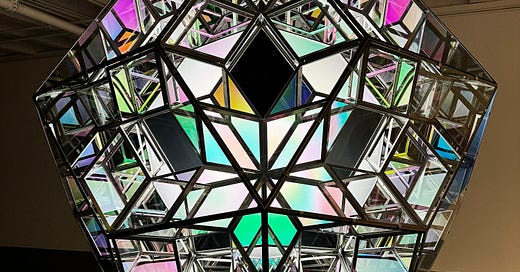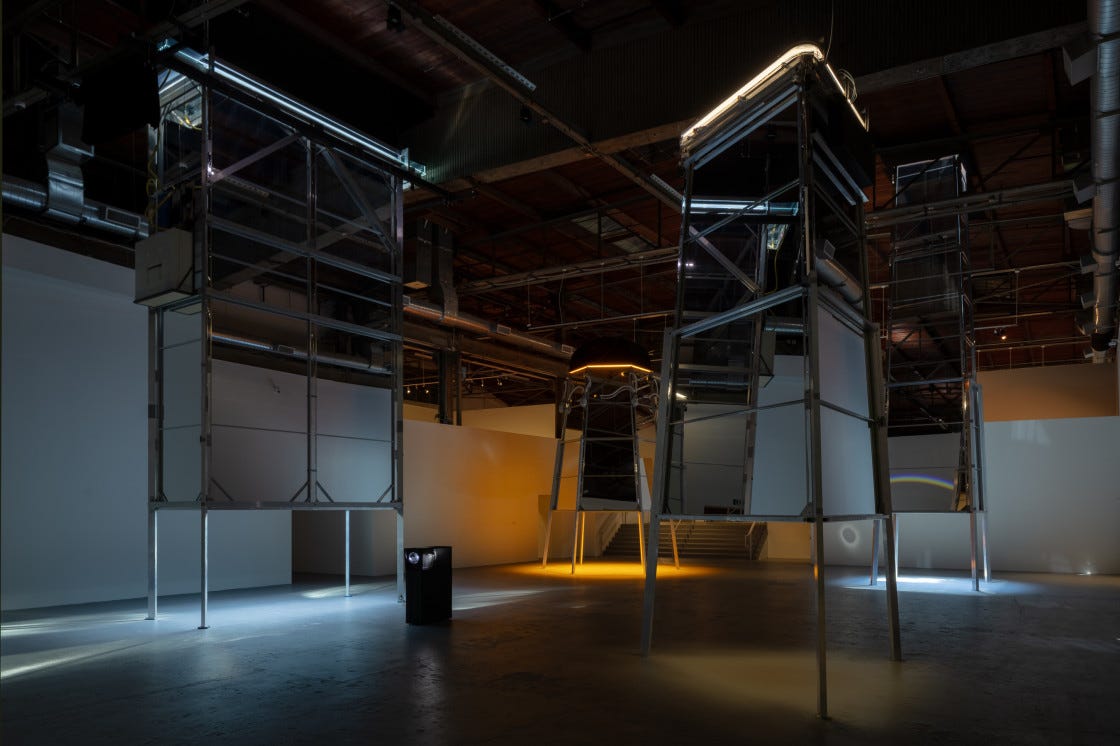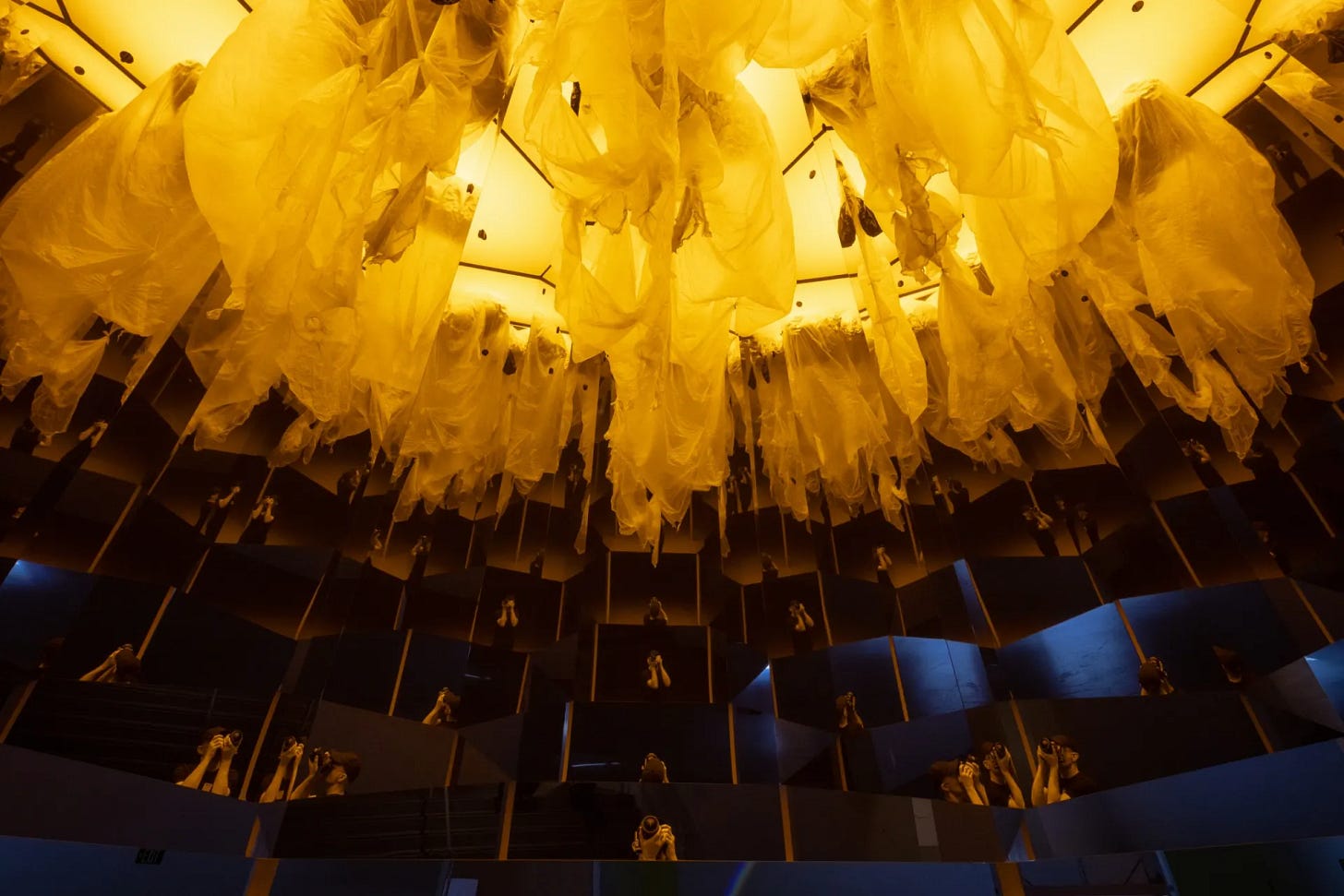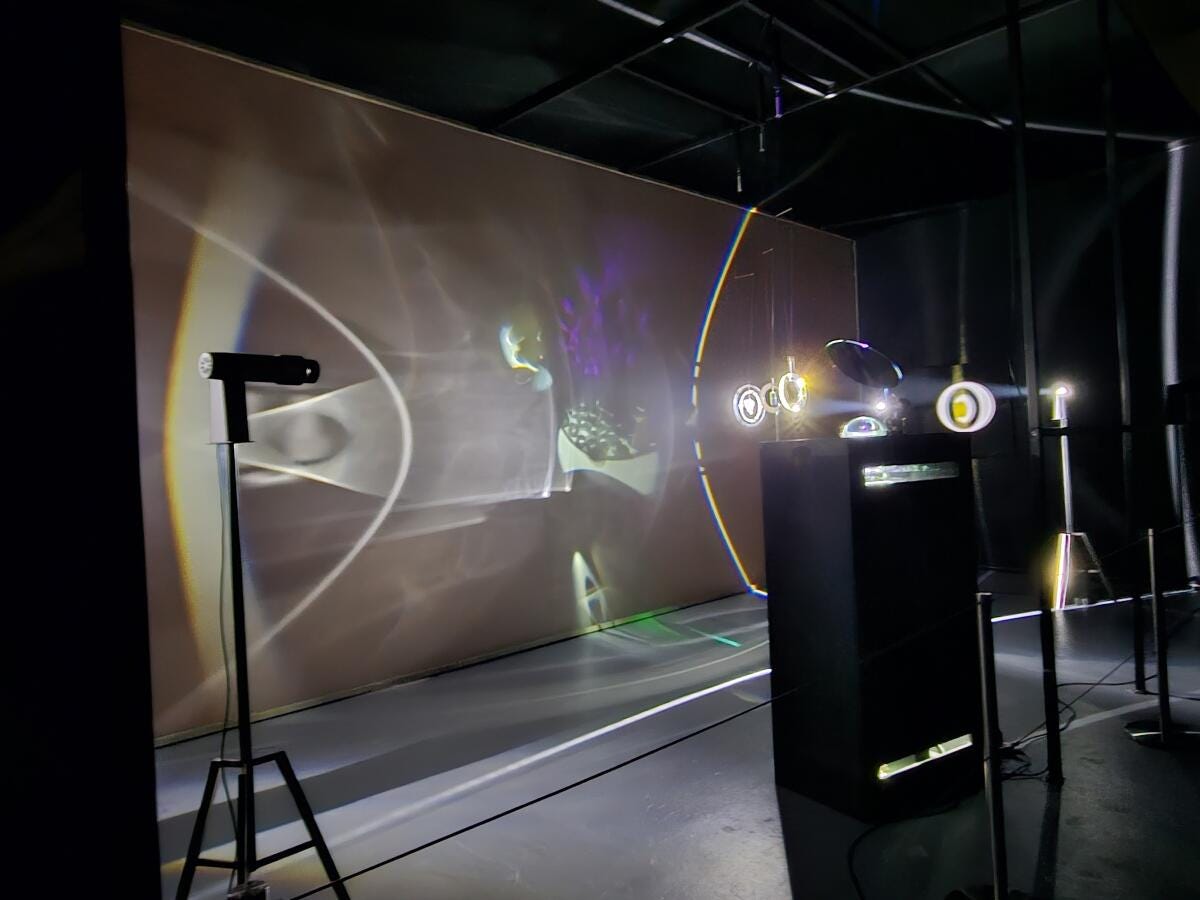Arriving at the old industrial warehouse that is the Geffen Center at MOCA, in Little Tokyo, one could hardly imagine the kaleidoscopic wonders that await inside. Entering the lighting is comfortably low, the space is vast before you with several towers made of metal and glass that attach to openings in the ceiling, light streaming through the divides between materials. Strange arched light reverberates on the back wall and flickerings from other hallways and halls beckon you on. This is OPEN, the new site specific installation show (with a few prior works) from famed Danish/Icelandic artist and designer Olafur Eliasson. Working from a set of prompt questions that appear at the start of the show, Eliasson has created devices, sculptures, and mobiles with his research studio that use both natural and artificial light to sharpen our perception of the world around us. He sees the entire show and the museum itself not as a walled garden to contemplate objects, but a vast set of binoculars with which to view more closely and clearly the world outside.
All of Olafur Eliasson’s work is centered on perception and how art can sharpen it, creating playful experiential pieces that push the viewer to look at the world and their place in it in a new way. The calming atmosphere of the show is intentional as Eliasson wants to “democratize the accessibility to art”, he wants to create a space where viewers can create their own stories and meanings to the works. Many of the pieces change according to where one is standing in relation to them, or only come to life with the reflection of the viewer in the work; thus making our presence essential to the art itself. With these ideas in mind let's explore in more depth three of the devices on display and their connections to Eliassons larger oeuvre.
Looking right as one enters the show, you see a metal and steel tower with a domed top, yellow light emitting from its sides and an opening at its bottom where one can walk under and look up. Looking like something out of the space age, the piece is called Device for Seeing Potential Futures, and inside it's a dystopian jewel box. Above your head six mirrors taper up to form a hexagon, yellow lights ( that the artist has been using in pieces since the nineties) form the dome, and plastic “space junk” is kept floating in perpetual motion by a wind machine. The reflections of the light create the image of a sun in the mirrors and our own faces are repeated hundreds of times floating below.
The so-called “space junk” creates a ghostly form that is constantly changing and gives kinetic energy to the work. Eliasson’s research showed that being bathed in a single color heightens our awareness of details and contrasts, and upon leaving the device our eyes see purple, yellow’s complementary color. The artist's works are always a mixture between science and art with a focus on environmental conservation and awareness. In this work we are pushed to think about the sick light of industrial spaces, or perhaps all the junk that we leave orbiting earth, maybe how we ourselves (as seen in the mirrors) are culpable in the sickening of our planet. The title makes us think about pollution and the threat of climate change, the sun shape, the fear of a warming world. Without a single clear cut meaning, the piece invites the viewer to build their own story around it, interrogate it, and come to their own conclusions. For Eliasson this is the point, he is opening his devices for your co-creation as long as you are open to them. He wants you to use them to see differently.
Entering a darker adjoining room one sees a scrim on the far wall, dancing across it is an ever changing light-show of forms, hues, and shadows. As one moves across the room and behind the scrim you see the ingenious device that creates the patterns and its many rotating components. The images on the scrim appear in two and three dimensions because of three spinning glass rings in the device. These rings have appeared in the artist's work since the two thousands and are illuminated by two spotlights as well as a third beam from a custom made kaleidoscopic box. The box consists of two discs facing horizontally, one has broken glass on it, the other plant bits in oil. A spotlight shines through both and out of the box. All parts of the apparatus rotate at different speeds creating what Eliasson calls “radically analogue films” that are constantly being changing and are dependent on the perspective of the viewer. The piece seems almost to be a meditative dance or the rotation of a solar system endlessly spinning. Made up mostly from saved parts of earlier devices, it speaks to the artist's recycling ethos and that, with what we already have, we can constantly create. The works' liquid forms and changes in color and light invite the viewer to explore its creation and think on the nature of sight and perception. The title, Pluriverse, speaks to the endless new forms possible, to the many parts that make up the whole, and to the many ways it can be viewed with each being true. Eliasson collects lenses and optical devices as well as conducting research on perception and the qualities of light, making machines like this both the perfect expression of his passions and an invitation to participate in them.
On the opposing side of the exhibition is a room filled with smaller devices and works, in one corner hangs an incredible multifaceted sculpture entitled Your Changing Atmosphere. Called a “polychromatic geometric sculpture” by the artist it is made of two identical forms, one inside the other, held together with a complex latticework. The shape is a rhombic triacontahedron, or a polyhedron made of thirty congruent diamond shaped facets; the lattice work derives from a pattern discovered during Eliasson’s studios research into quasicrystals. The interlocking shapes have panes of polarized plastic that take on color or go translucent depending on where the viewer is standing, some of which rotate, and a strong light glows from within. The piece almost seems to depict the inner workings of a star or a view into the multiverse, demonstrating Eliasson’s belief that art can make abstract concepts both relatable and physical. Similar to other star-like sculptures he has been creating for years, it shows Eliasson’s love of the latest innovations in materials and discoveries in abstract science. The title pushes the viewer to consider the tiny particles that make up our atmosphere, how fragile and thin that layer is and yet how essential for all life on earth. The fact that it changes color and form based on the viewer's position speaks to the impact we all individually have on this vital part of our ecosystem. It connects with the skylights in the other room in consideration of the theme of atmosphere and our role in it.
The entirety of OPEN is a perfect encapsulation of Olafur Eliasson’s ethos as an artist and passions as a researcher and philosopher. It invites you in to explore and play, then leaves you with deep questions of meaning and our place in the universe. He seamlessly blends science, art, activism and wonder into each piece and pushes himself with new research into the study of perception and light. All this work is done as an invitation to explore what he has explored, question what he has questioned, and see what conclusions you come to on your own. It is an invitation to contemplation and a magnifying glass to see more sharply the world around us. So I will leave you with the prompts that opened the show and the questions that drove Eliasson, in the hopes that it may open something new in you.
Am I OPEN to facing my numbness?
Am I OPEN to vulnerability?
Am I OPEN to receiving a No?
Am I OPEN to others perspectives?
Am I OPEN to slowness?
Am I OPEN engaging fully with my senses?
Am I OPEN to exploring where I place my attention?
Am I OPEN to fierce tenderness?
Am I OPEN to considering “why” instead of “how’?
Am I OPEN to relaxing my attachment to outcome?
Am I OPEN to wonder?
Am I OPEN to sharing? (our planet)









Love these insights Chris!